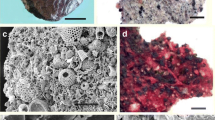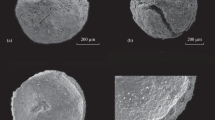Abstract
We present new data on xenophyophores from the Russian license area of the Clarion-Clipperton Zone (CCZ) in the abyssal eastern equatorial Pacific based on samples collected in box cores during cruises of the R/V “Yuzhmorgeologia” in 2009–2012. The new material yielded five species of these giant foraminifera: Psammina multiloculata Kamenskaya, Gooday, Tendal 2015, Spiculammina delicata Kamenskaya 2005, and three new species that we describe here. Aschemonella tubulosa sp. nov. is characterized by rounded stercomare masses attached to the inner organic layer of the tubular test. Cerelasma implicata sp. nov. lacks a distinct agglutinated test and consists largely of a mass of branching and closely intertwined granellare and stercomare strings, with a scattering of sponge spicule fragments and mineral grains on the outer surface. Stannophyllum paucilinellatum sp. nov. has weakly developed linellae distributed uniformly throughout the test without forming distinct surface or internal layers. All xenophyophore specimens, except for A. tubulosa, were attached to nodules. Xenophyophores are among the dominant megafaunal taxa within the CCZ. Our new material suggests that this region also houses many more novel species belonging to this group of protists.






Similar content being viewed by others
References
Amon DJ, Ziegler AF, Dahlgren TG, Glover AG, Goineau A, Gooday AJ, Wiklund H, Smith CR (2016) First insights into the abundance and diversity of abyssal megafauna in a polymetallic-nodule region in the eastern Clarion-Clipperton Zone. Sci. Rep. 6, doi:10.1038/srep30492.
Brady HB (1879) Notes on some of the Reticularian Rhizopoda of the “Challenger” Expedition. Part 1. On new and little known arenaceous types. Q J Micros Sci 19:20–63
Brady HB (1884) Report on the foraminifera dredged by H.M.S. Challenger during the years 1873–1876. Rep Sci Res Voyage of H.M.S. “Challenger” during years 1873–76. 9: 1–814
Costello MJ, Emblow CS, White R (2001) European Register of Marine Species. A check-list of the marine species in Europe and a bibliography of guides to their identification. Patrim Nat 50:1–463
Gooday AJ, Nott JA (1982) Intracellular barite crystals in two xenophyophores, Aschemonella ramuliformis and Galatheammina sp. (Protozoa: Rhizopoda) with comments on the taxonomy of A. ramuliformis. J Mar Biol Ass UK 62:595–605
Gooday AJ, Bett BJ, Pratt DN (1993) Direct observation of episodic growth in an abyssal xenophyophore (Protista). Deep-Sea Res 40:2131–2143
Gooday AJ, Aranda da Silva A, Pawlowski J (2011) Xenophyophores (Rhizaria, Foraminifera) from the Nazaré Canyon (Portuguese margin, NE Atlantic). Deep-Sea Res II 58:2401–2419
Haeckel E (1889) Report on the deep-sea Keratosa collected by H.M.S. Challenger during the years 1873–76. Report of the Scientific Results of the Voyage of H.M.S. Challenger during the years 1873–76. Zoology 32:1–92
Hess S, Kuhnt W (1996) Deep-sea benthic foraminiferal recolonization of the 1991 Mt Pinatubo ash layer in the South China Sea. Mar Micropaleontol 28:171–197
Hess S, Kuhnt W, Hill S, Kaminski MA, Holbourn A, de Leon M (2001) Monitoring the recolonization of the Mt Pinatubo 1991 ash layer by benthic foraminifera. Mar Micropaleontol 43:119–142
Hughes JA, Gooday AJ (2004) Association between living benthic foraminifera and dead tests of Syringammina fragilissima (Xenophyophorea) in the Darvin Mounds region (NE Atlantic). Deep-Sea Res I 51:1741–1758
Kamenskaya O (1997) Synopsis of the system of the class Xenophyophorea (Protozoa). Benthos of the northern Euro-Asian Seas. M VNIRO Publ. House: 43–56
Kamenskaya OE (2005) Spiculammina delicata gen. et sp. n., a new xenophyophore from the eastern Pacific (Psamminidae). Invertebr Zool 2(1):23–27
Kamenskaya OE, Melnik VF, Gooday AJ (2013) Giant protists (xenophyophores and komokiaceans) from the Clarion-Clipperton ferromanganese nodule field (Eastern Pacific). Biol Bull Rev 3(5):388–398
Kamenskaya OE (2014) Deep-sea fauna of European seas: An annotated species check-list of benthic invertebrates living deeper than 2000 m in the seas bordering Europe. Xenophyophores. Invertebr Zool 11(1):254–258
Kamenskaya OE, Gooday AJ, Tendal OS, Melnik VF (2015) Xenophyophores (Protista, Foraminifera) from the Clarion-Clipperton Fracture Zone with description of three new species. Mar Biodiv 45:581–595
Kaminski MA (2014) The year 2010 classification of the agglutinated foraminifera. Micropaleontol 60:89–108
Laubenfels MV (1936) Sponge fauna of the Dry Tortugas. Papers from the Tortugas Laboratory of the Carnegie Institution of Washington. 30: 1–225
Laubenfels MV (1948) The order Keratozoa of the phylum Porifera- a monographic study. Occ Pap Allan Hancock Fdn 3:1–217
Loeblich AR, Tappan H (1964) Treatise on Invertebrate Paleontology. Part C. Univ Kansas Press: 1–900
Lecroq B, Gooday AJ, Tsuchiya M, Pawlowski J (2009) A new genus of xenophyophores (Foraminifera) from the Japan Trench: morphological description, molecular phylogeny and elemental analysis. Zool J Linn Soc-Lond 156:455–464
Levin LA (1994) Paleoecology and ecology of xenophyophores. Palaios 5:32–41
Levin LA, Thomas CL (1988) The ecology of the xenophyophores (Protista) on eastern Pacific seamounts. Deep-Sea Res 35(12):2003–2027
Levin LA, DeMaster DJ, McCann LD, Thomas CL (1986) Effects of giant protozoans (class: Xenophyophorea) on deep seamount benthos. Mar Ecol Prog Ser 29:99–104
Pawlowski J, Holzmann M, Fahrni J, Richardson SL (2003) Small subunit ribosomal DNA suggest that the xenophyophorean Syringammina corbicula is a foraminiferan. J Eukaryotic Microbiol 50:483–487
Pawlowski J, Holzmann M, Tyszka J (2013) New supraordinal classification of Foraminifera: Molecules meet morphology. Mar Micropaleontol 100:1–10
Schepotieff A (1912) Untersuchungen über neidere Organismen II. Die Xenophyophoren des Indischen Oceans. Zool Anat Ontog Tiere 32:245–286
Schulze FE (1907a) Die Xenophyophoren, eine besondere Gruppe der Rhizopoden. -Wiss. Ergebn. dt. Tiefsee-Exped. Valdivia 11:1–55
Schulze FE (1907b) Die Xenophyophoren. Bull Mus Comp Zool Harv 51:143–162
Tendal OS (1972) A monograph of the Xenophyophoria (Rhizopoda, Protozoa). Galathea Rep 12:7–99
Tendal OS (1980) Xenophyophores from the French expedition “INCAL” and “BIOVEMA” in the Atlantic Ocean. Cah Biol Mar 21:Cah Biol Mar 21:03–306
Tendal OS (1980b) Stannophyllum setosum sp.n., a remarkable xenophyophore (Rhizopodea, Protozoa) from the Eastern Pacific. Cah Biol Mar 21:383–385
Tendal OS (1996) Synoptic checklist and bibliography of the Xenophyophorea (Protista), with a zoogeographical survey of the group. Galathea Rep 17:79–101
Voltski I, Pawlowski J (2015) Flexammina islandica gen. nov. sp. nov. and some new phylotypes of monothalamous foraminifera from the coast of Iceland. Zootaxa 3964(2):245–259
Acknowledgments
We thank three anonymous Reviewers whose helpful comments helped to improve the manuscript. The study of xenophyophores is supported by the following: OEK partly by the European Union Seventh Framework Programme (FP7/207-20130 under the MIDAS project, grant agreement no 603418) and partly by the Russian Science Foundation Grant 14-50-00095 (taxonomic analysis).
Author information
Authors and Affiliations
Corresponding author
Additional information
Communicated by S. S. M. Kaiser
Rights and permissions
About this article
Cite this article
Kamenskaya, O.E., Gooday, A.J., Tendal, O.S. et al. Xenophyophores (Rhizaria, Foraminifera) from the Russian license area of the Clarion-Clipperton Zone (eastern equatorial Pacific), with the description of three new species. Mar Biodiv 47, 299–306 (2017). https://doi.org/10.1007/s12526-016-0595-x
Received:
Revised:
Accepted:
Published:
Issue Date:
DOI: https://doi.org/10.1007/s12526-016-0595-x




